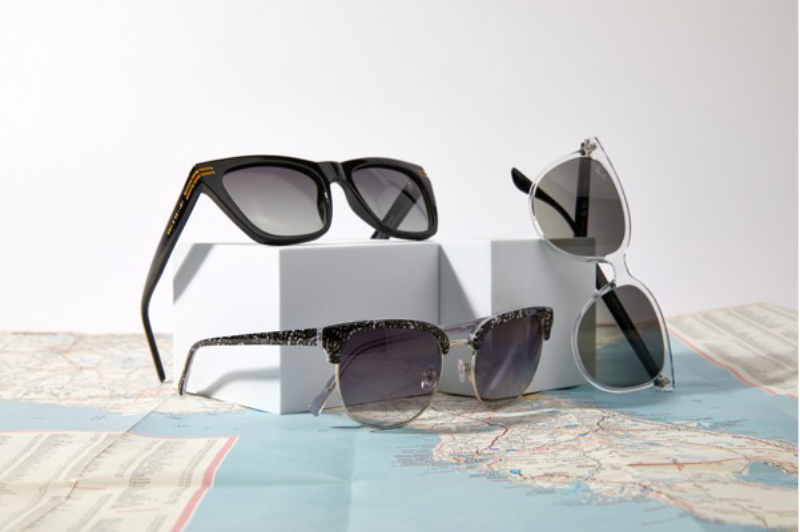
Our eye care specialists are here to help you see your best. Buy two pairs of glasses and the exam is on us!
Everything you need to know to take care of your eyes — for life.
You don’t need to switch between sunglasses and eyeglasses to see clearly while protecting your eyes from the sun’s harmful ultraviolet rays.

Sunglasses are a must-have when it comes to eyewear.
It’s not just that you channel your inner Jackie O. when you put on a pair. They’re so much more than fashion accessories — they’re key to protecting your eyes from damaging ultraviolet (UV) rays, the radiation emitted by the sun, says Stephanie Cathell, O.D, an optometrist who practices at America’s Best Contacts & Eyeglasses in Union City, New Jersey.
But it can be tricky to wear sunglasses if you already wear a pair of regular eyeglasses. If you take your eyeglasses off, you can’t see. And wearing sunglasses over your eyeglasses might look a little silly.
You can wear sunglasses over contact lenses, but what if you don’t always feel like putting in your contact lenses? Or what if you’re spending a day at the pool or beach? Wearing contact lenses while swimming can lead to eye infections.
Enter: prescription sunglasses. These shades combine clear vision with important UV eye protection. Here’s what you need to know about prescription sunglasses, plus what to look for when you pick out your own pair.
Prescription sunglasses are sunglasses that have a prescription for vision in the lens to help you see 20/20.
“They’re just like regular prescription glasses that correct refractive error,” explains Dr. Cathell.
The difference, she notes, is that the lenses are tinted and UV-coated to protect your eyes and surrounding skin from the sun’s rays.
Eye exams are an essential part of your health care routine. Book an appointment with your America’s Best optometrist today!
There are two main types of prescription sunglasses, says Dr. Cathell.
Polarized prescription sunglasses. This is a special type of tinted lens that protects your eye from the glare and strain that’s associated with sun rays.
“It’s coated in a special chemical that reduces horizontal rays, which are the rays that come off a horizontal surface, such as a body of water or snow,” explains Dr. Cathell.
As a result, only vertical rays can pass through. This significantly reduces glare. “They’re ideal for any sort of outdoor activity that has glare from water or snow, like fishing or skiing,” she adds.
But these sunglasses aren’t for every occasion. Polarized lenses may make it harder to see the screens of your cell phone, car dashboard, or any other device that has an LED (light-emitting diode) or LCD (liquid crystal display) screen.
Photochromatic (transition) prescription sunglasses. This is what you could call an all-in-one lens, says Dr. Cathell. They automatically darken in bright sunlight and revert to clear once you’re back indoors.
“This feature can be added to a regular day-to-day pair of lenses, so that they automatically transition from clear to tinted,” she explains. “They’re activated by outdoor UV rays.”
Photochromatic lenses may take longer to adjust in cold weather, and they don’t darken inside cars as well. “Auto glass has some UV protection that prevents transition lens from darkening,” says Dr. Cathell.
And these lenses aren’t recommended for everyone, including certain older adults. Since they can take up to 30 seconds to transition from dark back to light, it may increase your risk of falling when you move from the outdoors to a darker indoor environment.
Recommended reading: Sunglasses vs. Photochromic Lenses for Older Adults
Prescription sunglasses are a convenient way to see clearly and comfortably while protecting your eyes from damaging UV light.
If you’re exposed to UV light without proper eye protection, says Dr. Cathell, it raises your risk of eye diseases such as:
It’s important to remember that even very short-term sunlight exposure may damage your eyes. If you look directly at the sun without sunglass protection, even for a few seconds, it can bring on a blind spot called solar retinopathy that takes typically three to six months to heal.
If you’re doing an activity where the sun reflects off snow or water, you can develop photokeratitis, or a painful sunburn on the front part of your eye.
“That’s why prescription sunglasses are a great option for anyone who needs corrective lens and can’t wear contacts,” explains Dr. Cathell. They’re also more comfortable than traditional clip-on glasses that fit over your existing frames.
Recommended reading: 5 Reasons to Wear Sunglasses Every Day
Press play to learn more about why wearing sunglasses is important:
Yes. There are three main options: CR39, polycarbonate, and high index. Here’s a closer look.
CR39. This is a simple plastic lens. “It’s the most basic option, and it is very lightweight,” says Dr. Cathell.
Polycarbonate. Most sunglasses are made with this material, which is a strong, impact-resistant plastic, notes Dr. Cathell.
“It’s shatter-resistant so it’s the best option if you’re doing a lot of outdoor activities that require more safety, like playing a sport such as baseball or tennis,” she says.
High index. This is a good option for people who have a very strong eyeglass prescription that requires thicker lenses to see well.
These types of lenses bend light more efficiently, so they require less material. As a result, they are thinner and lighter than traditional prescription lenses.
“It prevents the look of Coke-bottle glasses,” says Dr. Cathell. Consider them if your prescription is +/-4.00 or more.
Most block 100% of both UVA and UVB light, unlike nonprescription lenses, says Dr. Cathell.
The only exception may be polarized lenses, since polarization itself doesn’t provide UV protection, she notes. If you buy them, make sure that they’re made with a UV-blocking substance.
If you have prescription lenses that aren’t sunglasses but are tinted, those usually don’t provide full UV protection either, says Dr. Cathell. Always check with your eye doctor.
“The bottom line is prescription sunglasses offer the best UV protection,” says Dr. Cathell.
You absolutely can. Here are the three main types of multifocal lenses:

Make sure that they’re oversized or wraparound-style. (Shop our latest styles here.)
“The more coverage from sunglasses, the less sun damage not only on your eyes but also on the areas around your eyes — like your eyelids — that can also develop cancerous lesions,” says Dr. Cathell.

Our eye care specialists are here to help you see your best. Buy two pairs of glasses and the exam is on us!
Wear your prescription sunglasses every day when you’re outdoors or in your car, says Dr. Cathell.
This is true even during the middle of winter or on cloudy days. Harmful UV rays will still be present. And remember, on warm, sunny days, you may need even more protection. Wear a wide-brimmed hat to cut down even more on UV exposure to your eyes.
Yes, prescription sunglasses are usually more expensive than regular eyeglasses.
“When you add any feature to prescription glasses, the cost goes up,” says Dr. Cathell. “In this case, the lens is chemically treated to provide UV protection, and there’s just more of a process in general to create the lens.”
Cost varies according to lens type, too. A simple pair of CR39 lenses, for example, will cost less than progressives with a high-index lens.
You can help stick to a budget by using your flexible spending account (FSA) or health savings account (HSA), so that you pay with pretax dollars. You can also take advantage of America’s Best two-pair offers to save.
Just remember, you don’t have to spend a fortune to get solid eye protection. Most pairs of prescription sunglasses will provide 100% UV blocking, which is what you want.
If you’re familiar with caring for regular eyeglasses, you should have no problem caring for prescription sunglasses. The steps are the same.
Dr. Cathell suggests the following:
It’s as simple as scheduling an eye exam with your America’s Best optometrist. They can provide you with a specific prescription for sunglasses at the same time as a prescription for regular glasses, says Dr. Cathell.
Click here to find an exam time that fits your schedule.
Recommended reading: Sunglasses for Eye Health: The Definitive Buyer’s Guide
See our sources:
Lens options and add-ons at America’s Best Contacts & Eyeglasses
Prescription sunglasses lenses: American Academy of Opthalmology